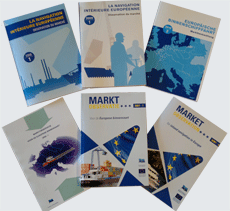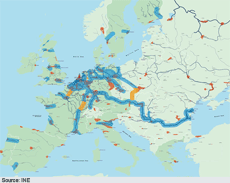Market observation
The CCNR has been involved in market observation since 2004 together with the European Commission, which co-finances 50% of its activities, and with the inland navigation profession. Initially based on Rhine information and approaches, this economic monitoring tool was gradually extended to the entire European network of waterways, where reliable data are available and enable analyses to be conducted. In general this is an evolutive project, and new approaches are constantly added in accordance with needs and possibilities.
The aims of market observation

Market observation targets the regular provision of data to identify general and structural trends within the inland shipping sector, estimate economic performance, and draw up medium-term forecasts on the basis of econometric models. Though the results are mainly intended for political decision-makers, they may also be of interest to a wider audience.
This observation tool is created on the basis of indicators of the various aspects and factors affecting the inland shipping market. In the publications their trends are analysed and commented on over several years. Among the main approaches employed are the following:
- the general and structural trends of supply and demand in the transport sector (carriage of goods and passengers);
- market operating conditions (freight, cargo operating rate, operating costs, investment capacity, hydraulicity);
- trends in the modal share of inland shipping on its various markets;
- job market trends in connection with inland shipping;
- safety aspects (accidentology etc.);
- the structure of the profession.

The geographic field

Market observations cover the entire European network of navigatable media, including Switzerland, and some Danube States such as Serbia and Croatia which are not EU Member States but whose territory is crossed by the River Danube. The various geographic markets are analysed in due consideration of their specific details.

The methodology
Transport demand is monitored on the basis of the volumes transported (in tonnes) and of the services provided (tkm).
The river transport market is analysed over three sectors: the dry cargo sector, comprising bulk transport and container transport, the tanker sector, and the passenger craft sector, including daily sailings and cruise vessels.
For goods transport, a distinction is made between certain specialist segments within the sectors concerned.
The sector segments are as follows:
dry cargo sector:
the traditional bulk transport markets:
- iron and steel (ore and metallurgy products)
- energy: coal
- construction and civil engineering
- agriculture
- chemicals
new markets: combined transport:
- container transport
- ro-ro transport
- distribution
tanker sector:
- energy: light and heavy oil products
- chemicals: chemical products and liquefied gases
Transport supply is analysed on the basis of the capacity (tonnage) of potentially active fleets on the European network. "Potentially active" vessels are those that have the necessary navigation certificates and can thus provide an immediate response to a transportation request.
The intersection of market supply and demand produces the volume of cargo. This is the most important index for a microeconomic appraisal of operations by the companies concerned.
Analysis of trends in these three items enables a broad evaluation to be drawn up of the economic situation of this means of transport. Since transport supply and demand are located on a mesoeconomic level, whereby the volume of cargo combined with the services or volumes transported provides an assessment of the overall direction taken by economic activity within the sector. When this trend is compared with that of the main operating costs, this provides an idea of movements in the investment capacity of inland shipping.
In addition to these major components, consideration is also given to certain exogenous factors which could be decisive in terms of development. Namely:
- hydraulicity on free-current rivers;
- competition situations and modal sharing for market segments and core specialities;
- the job market and availability of sufficient amounts of skilled labour;
- the capacity of infrastructures (locks, ports, multimodal terminals at harbours etc.).
Publications in connection with market observation
Analyses and information gleaned from this economic monitoring of inland shipping are available on the CCNR's web site (www.ccr-zkr.org), and are also available as hard copy from the secretariat (ccnr@ccr-zkr.org):
- full reports (spring/autumn)
- interim general reports
- miscellaneous statistical information
The organisation of market observation
Market observation is carried out within the scope of cooperation between the profession's international organisations EBU and ESO, the secretariat of the Central Commission, and the European Commission's Directorate-General for Mobility and Transport (DG MOVE). It is implemented by the Central Commission's secretariat.
Work structure:
The following working bodies were created in a bid to carry out concerted, focused market observation:
- Project partners management committee;
- A Market Observation working group (G/OM);
to examine and enhance the methodology, consisting of the national representatives of EU Member States and of the CCNR, with representation from the profession.
For the purposes of implementation, the CCNR secretariat is assisted by a group of experts in the profession concerning the Western European market, while regional forums are arranged for the Danube market.


